
Fort Bragg and Fayetteville, North Carolina
Going to Fort Bragg
"Go to Fort Bragg", they said,
"and teach this very introductory cybersecurity
course to some staff at
U.S. Army Special Operations Command."
OK, that sounds interesting.
Who should I talk to there to find out more about the
people who will be attending?
"Oh, don't worry about that!
It's about a dozen people and this course is
exactly what they need!"
Well, that sounds reasonable. It is an awfully introductory course, with material explaining that there are these things called viruses and other malware, and they're bad, and there are these good things called firewalls and here is how they work. But an awful lot of government employees in the Washington, D.C. area find all that very novel and useful to learn about.
As it turns out, a program director at USASOC had said that his people needed training in advanced computer network defense with lots of hands-on lab work. A salesperson had said that this course, which happened to be the extremely introductory one with zero hands-on work, was exactly what they needed.
And there I was in the middle of the mess...
After the introduction, it was quite clear that the course material and software was not at all what was needed. I asked them what I should do, and it ended up with me using the course material as just an outline and telling them and free-hand drawing the sort of content that might be in the second course following the scheduled one.
The course was called off after the second day, and I'm surprised it went on that long. The next day started with packing equipment and material into crates and was followed by a meeting with the program manager to figure out exactly what they did need and how that could be put together. I was then left with some unexpected free time to look around Fayetteville, North Carolina. I had already looked around the old downtown in the evenings.
Fayetteville
Hay Street is the main street through the old downtown of Fayetteville. It's nicely fixed up and lined with a variety of businesses.

Other parts of Fayetteville are not necessarily so nice. On the one hand, Where to Retire magazine named Fayetteville as one of the best places to retire, while in 2008, BestLife Magazine used a variety of statistics about health, law enforcement, and education to rank Fayetteville as the 3rd worst city in which to raise a family, and its crime rate is very high in proportion to its population.
The area has been inhabited for over 12,000 years by a number of Native American peoples. Two settlements were established by Scots in the 1710s along the upper Cape Fear River. After the American Revolutionary War, the two towns joined and the combination named to honor General Lafayette. Lafayette visited in 1825.
The Market House was built in 1832 on the ruins of the old State House. Fayetteville lost out to Raleigh as the permanent state capital in 1788. It is a rare American example of a town hall and market structure common in England.
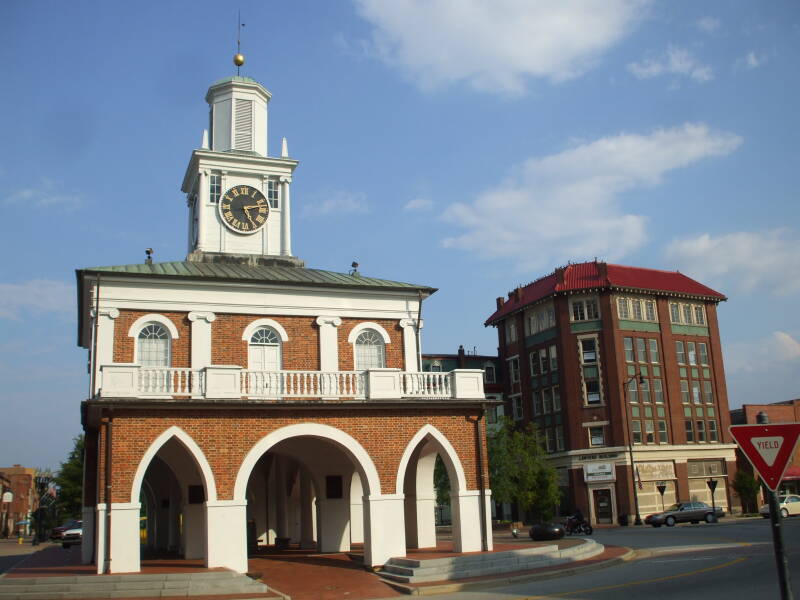
Meat, produce and, this being the South, slaves were sold in the arched arcade at street level. The market hall served as the town market until 1906. The second floor held the town hall and general meeting facility. It was the Fayetteville Town Hall until 1907.
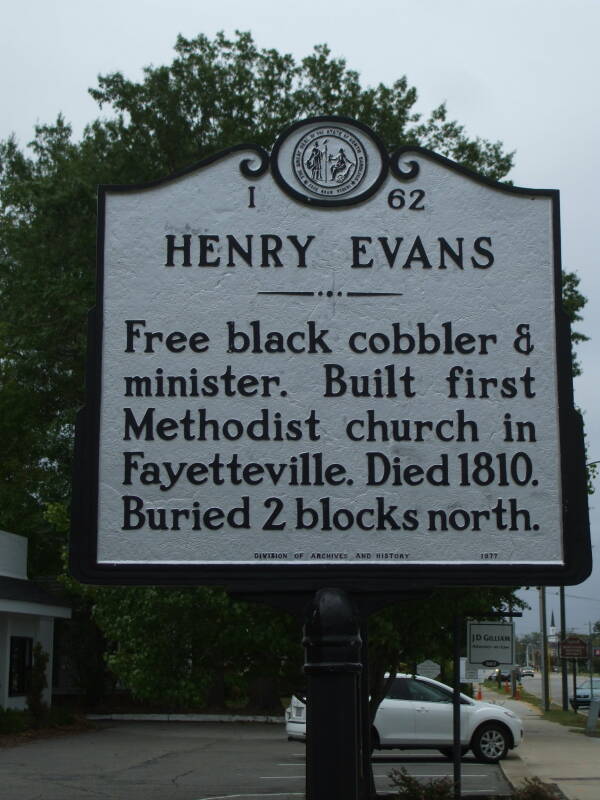
Henry Evans
Henry Evans is a major figure in regional Methodist history, founding a congregation here in 1790. This was just six years after the Methodist Episcopal Church was officially founded at a meeting in Baltimore in 1784. Bishop William Capers wrote about Evans in his autobiography, which was quoted in the article "Henry Evans and Negro Methodism" in The Southern Workman, volume 43, issue 12 (Dec 1914), pp 688-691.
The Southern Workman, December 1914.This periodical was published by the Hampton Normal and Agricultural Institute of Hampton, Virginia, which described itself as: "An undenominational industrial school founded in 1868 by Samuel Chapman Armstrong for Negro youth. Indians admitted in 1878."
Bishop Capers introduces his story of Henry Evans in an unusual way:
"But the most remarkable man in Fayetteville when I went there, and who died during my stay, was a Negro, by the name of Henry Evans. I say the most remarkable in view of his class; and I call him Negro with unfeigned respect. He was a Negro: that is, he was of that race, without any admixture of another. The name simply designates the race, and it is vulgar to regard it with opprobrium. I have known and loved and honored not a few Negroes in my life, who were probably as pure of heart as Evans, or anybody else. Such were my old friends, Castile Selby and John Boquet, of Charleston, Will Campbell and Harry Myrick, of Wilmington, York Cohen, of Savannah, and others I might name. These I might call remarkable for their goodness. But I use the word in a broader sense for Henry Evans, who was confessedly the father of the Methodist Church, white and black, in Fayetteville, and the best preacher of his time in that quarter; and he was so remarkable as to have become the greatest curiosity of the town; insomuch that distinguished visitors hardly felt that they might pass a Sunday in Fayetteville without hearing him preach."
It is said that Evans was born in Virginia of free parents, and as he was "almost too feeble to stand" at the time of his death in 1810 we may perhaps safely carry back the date of his birth to 1730 or 1735. He became a Christian and a Methodist when quite young and was licensed to preach in Virginia. There is a report also that he removed from Virginia to the neighborhood of Doub's Chapel in what was then Stokes, now Forsyth County, North Carolina, and while there was also licensed to preach. He stayed there about a year, but being a shoemaker by trade and thinking to improve his financial condition, he determined to remove to Charleston, South Carolina. It was while on his way southward from Stokes that he was detained for a few days in Fayetteville. Here, like Saint Paul, his spirit was stirred within him "at perceiving that the people of his race in that town were wholly given to profanity and lewdness, never hearing preaching of any denomination, and living emphatically without hope and without God in the world."
Bishop Capers then continues his narrative as follows:
"This determined him to stop in Fayetteville; and he began to preach to the Negroes, with great effect. The town council interfered, and nothing in his power could prevail with them to permit him to preach. He then withdrew to the sandhills outside of the town and held meetings in the woods, changing his appointments from place to place. No law was violated, while the council was effectually eluded; and so the opposition passed into the hands of the mob. These he worried out by changing his appointments, so that when they went to work their will upon him he was preaching somewhere else. Meanwhile, whatever the most honest purpose of a single heart could do to reconcile his enemies was employed by him for that end. He eluded no one in private, but sought opportunities to explain himself; avowed the purity of his intentions; and even begged to be subjected to the scrutiny of any surveillance that might be thought proper to prove his inoffensiveness.
"Happily for him and the cause of religion, his honest countenance and earnest pleadings were soon powerfully seconded by the fruits of his labors. One after another began to suspect their servants of attending his preaching, not because they were made worse, but wonderfully better. The effect on the public morals of the Negroes, too, began to be seen, particularly as regarded drunkenness and their habits on Sunday. It was not long before the mob was called off by a change in the current of opinion, and Evans was allowed to preach in town.
"At that time there was not a single church edifice in the city, and but one congregation (Presbyterian) which worshipped in what was called the statehouse, under which was the market; and it plainly Evans or nobody to preach to the Negroes. Now, too, not a few mistresses and some masters were brought to think that the preaching which had proved so beneficial to their servants might be good for them also; and the famous Negro preacher had some whites as well as blacks to hear him. Among these were my old friends, Mr. and Mrs. Lumsden, Mrs. Bowen (for many years preceptress of the Female Academy), Mrs. Malsby, and, I think, Mr. and Mrs. Blake. From these the gracious influence spread to others, and a meeting-house was built. It was a frame of wood, weather-boarded only on the outside, without plastering, and about fifty feet long by thirty feet wide."
That first church building was in place by 1803, as Methodist Bishop Francis Asbury recorded in his journal during a visit. Henry Evans lived in a room behind the pulpit, and continued to live there after poor health required him to give up his preaching duties. He died in 1810, mourned by the entire community, and he was buried under the chancel of the church. His grave was moved to the nearby Evans Metropolitan A.M.E. Zion Church.
Unfortunately, I had not read about Henry Evans during my day of tourism, so I didn't see that newer church.
Here we're looking east across the intersection of — no joke — Hay Street and Ray Street, plus a rail line. That's a United Methodist church just across the intersection and a Baptist church down the narrow Old Street, lined with, well, some of the older buildings in town.
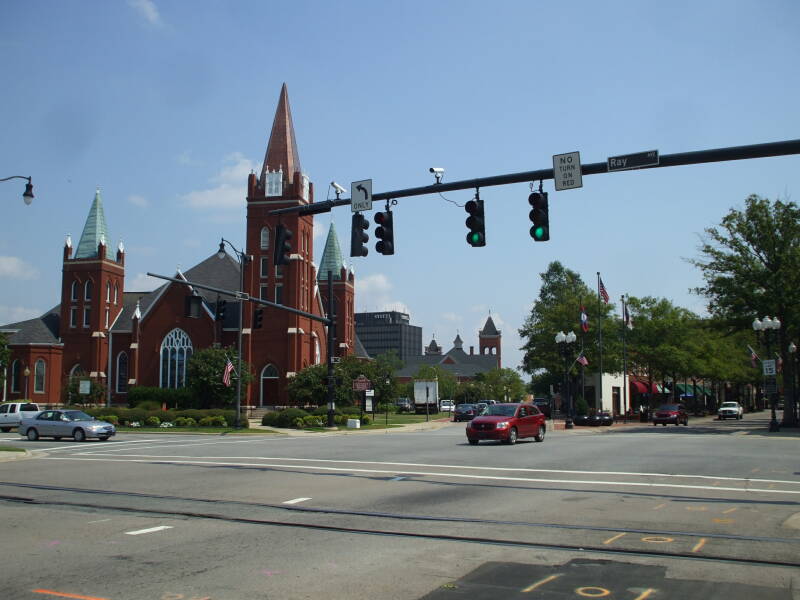
The Methodist Episcopal church started splitting soon after its formation. Among these new churches splitting off were the African Methodist Episcopal Church in 1816 and African Methodist Episcopal Zion Church in 1820, both of which were formed because of racial discrimination faced by those who became its members. The AME and AME Zion churches now have about 2.5 million and 1.4 million member, respectively, and it's the local AME Zion church that sees itself as continuing the legacy of Henry Evans.
Centuries before this in Europe, the Norse raiders, the Varangians and Rus' who came to be known as the Vikings, had captured and enslaved militarily weaker peoples, calling them Þræll in Old Norse or thrall as we spell it today. The thrall system of slavery was dominant through Scandinavia. Then the Vikings began to convert to Christianity with the 988 Christianization of Kievan Rus'. The early bishops held that a Christian could not morally own another Christian, a first step toward the abolition of slavery throughout Scandinavia by the mid-14th century.
Well, the American South of the 19th century was nowhere near as modern and progressive as the mid-14th-century Viking culture. John Wesley, the English founder of Methodism, was appalled by American slavery. The Methodist Episcopal Church had officially opposed slavery since its founding, but its members and even its clergy in the south owned slaves.
In 1840, the Reverend (and Bishop) James Osgood Andrew of Oxford, Georgia, bought a slave. He came to fear that she would end up with a cruel owner if he sold her, and while the church considered the case, he was not expelled. He probably was correct. But then in 1844, Bishop Andrew married a woman who owned a slave she had inherited from her mother, so the bishop now owned two slaves.
The 1844 General Conference (the main national meeting of the church organization) voted to suspend the bishop until he no longer owned slaves. This, of course, was unacceptable in the slave-owning South, and Methodists in the future Confederacy broke off and formed a separate denomination, the Methodist Episcopal Church, South (or MEC-S).
Once the American Civil War ended, many black Methodists in the south were able to leave the MEC-S for the AME and AME Zion churches, as well as the Methodist Episcopal Church which had been anti-slavery all along.
The MEC-S continued to grow in the south, becoming almost entirely white by 1880. Most of it eventually re-merged in 1939 with the Methodist Episcopal Church and the Methodist Protestant Church (another early 1800s group that had split off over a dispute about church governance). More conservative MEC-S members refused that merger and formed the Southern Methodist Church, a group that is now down to about 6,000 members.
That 1939 merger and another in 1968 formed the United Methodist Church, and Fayetteville's is seen above and below.
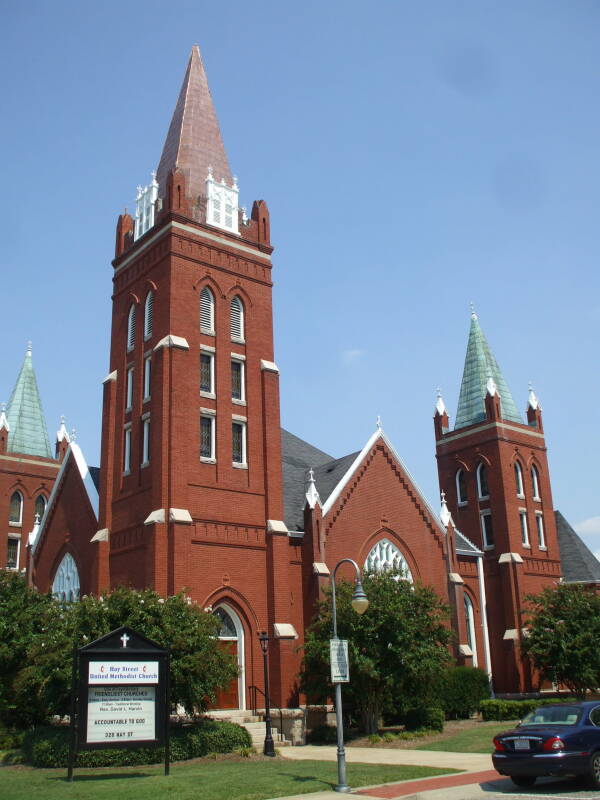

The stained glass windows are said to be especially nice, There's just a hint of that looking in from outside.
You can start to see the colors with the saturation cranked up to 160% with ImageMagick. But it's the texture of the robes that is supposed to be especially realistic.
Getting to and from Fayetteville
The Fayetteville passenger rail station was built in 1911 by the Atlantic Coast Railroad.
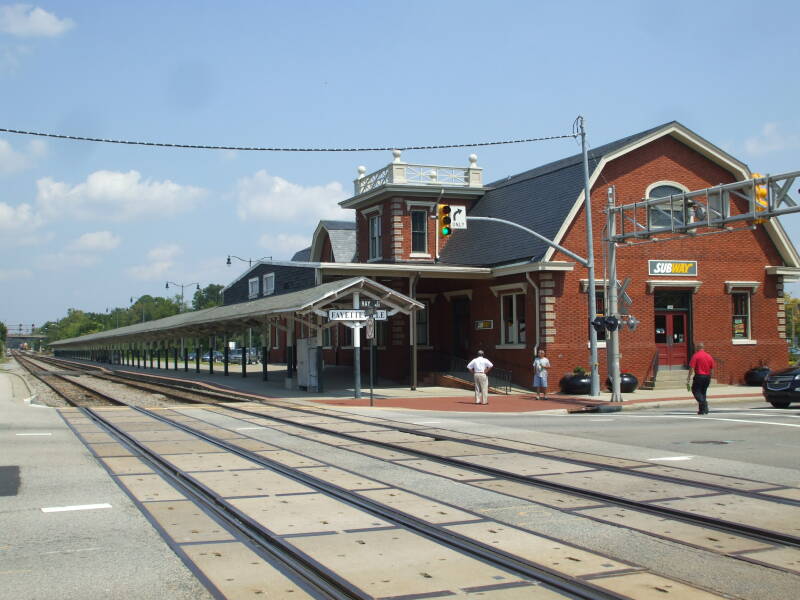
Amtrak service passes through twice a day in each direction, about 1 PM and 3:45 PM in the afternoons and around 12:45 AM and 1:30 AM overnight. The Palmetto, Amtrak train #90, has the more convenient arrival times in Fayetteville. It could provide a pleasant way of getting to Fayetteville.
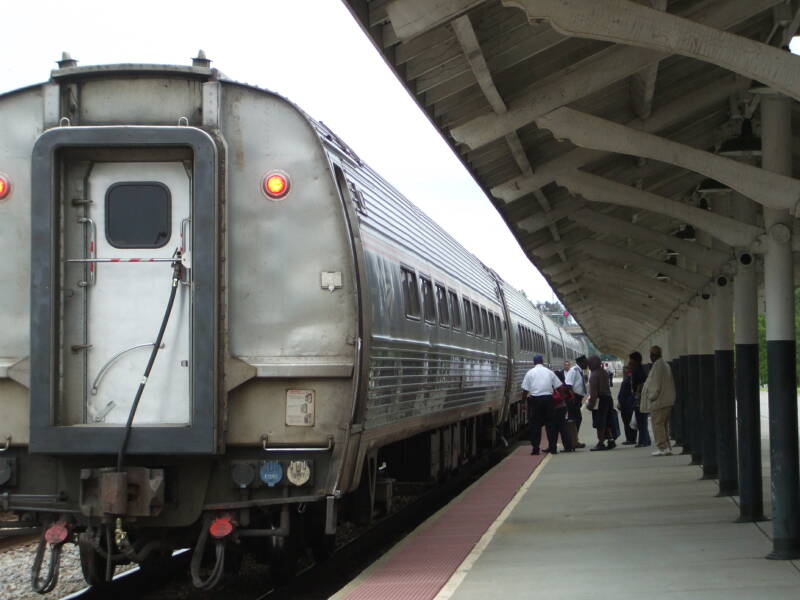
This Amtrak schedule just lists a few of the many station stops, and it very likely has changed by now. However, it will give you some idea of the general times the trains stop in Fayetteville and how long it takes to get to and from there.
| South ⇓ | Station | North ⇑ | ||
|
Palmetto #89 |
Silver Meteor #97 |
Silver Meteor #98 |
Palmetto #90 |
|
| 0615 | 1515 | New York NY | 1106 | 2347 |
| 0737 | 1658 | Philadelphia PA | 0931 | 2141 |
| 0854 | 1820 | Baltimore MD | 0816 | 2050 |
| 0955 | 1930 | Washington DC | 0721 | 1957 |
| 1150 | 2140 | Richmond VA | 0425 | 1715 |
| 1544 | 0134 | Fayetteville NC | 0045 | 1304 |
| 1915 | 0506 | Charleston SC | 2123 | 1000 |
| 2103 | 0644 | Savannah GA | 1932 | 0820 |
| 0923 | Jacksonville FL | 1648 | ||
| 1255 | Orlando FL | 1323 | ||
| 1855 | Miami FL | 0820 | ||
There's a large old hotel near the train station. I was surprised at the size of the hotel, given Fayetteville's population. It had been closed down for safety reasons shortly before my visit.
Amtrak reports that approximately 140 passengers board or arrive at their Fayetteville station on a typical day. But more travellers come and go by air these days. Delta, American, and US Airways each fly several commuter flights in and out of the Fayetteville Regional Airport every day.
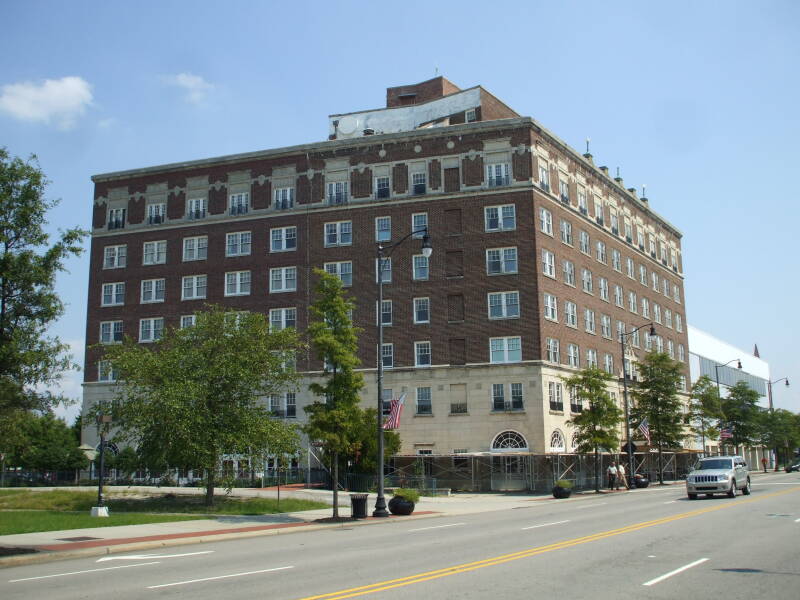
Fayetteville's proportionally large military presence makes things a little different there. You see billboards for products you normally don't see advertised outside Soldier of Fortune magazine — ballistic eyewear, or as in this large advertisement inside the airport, battlefield trauma coagulant packs.
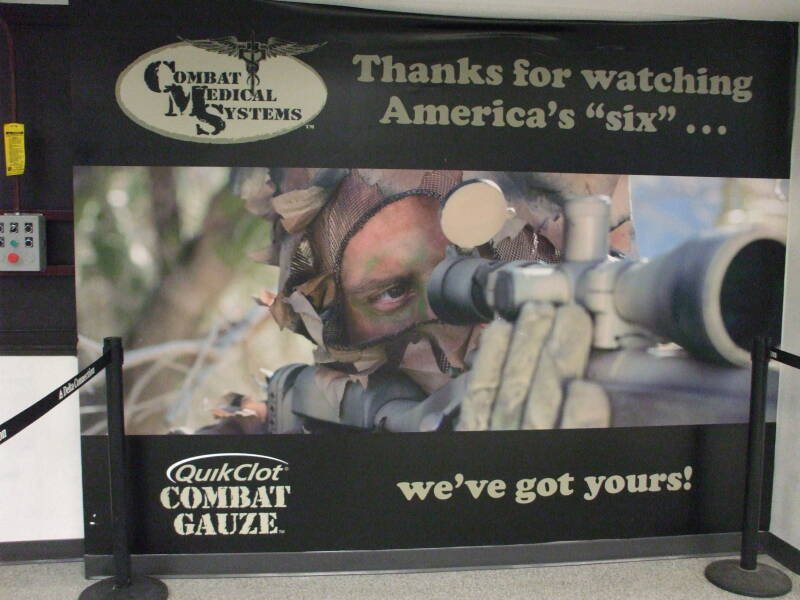
Fort Bragg did not send large units to Vietnam, but more than 200,000 soldiers trained there from 1966 to 1970 on their way to Southeast Asia. Some people still refer to the town as "Fayettenam".
Military Museums
So, to the military museums!
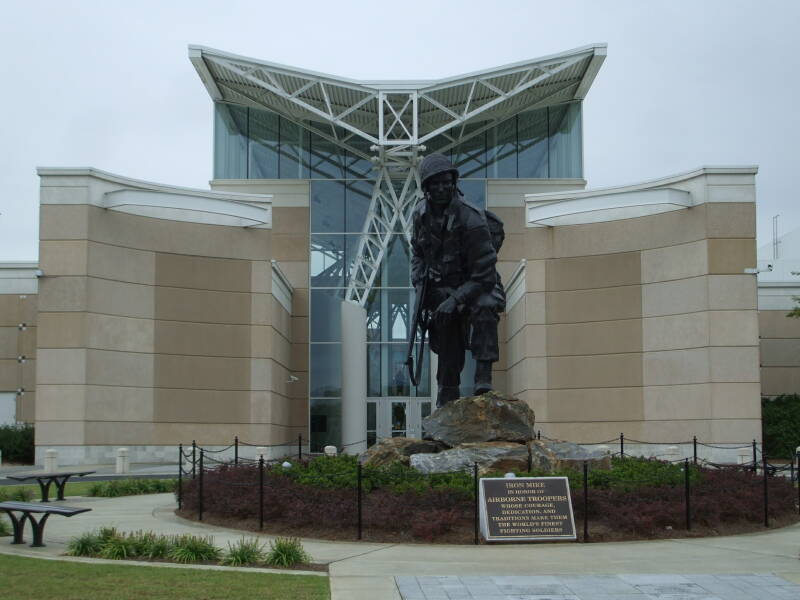
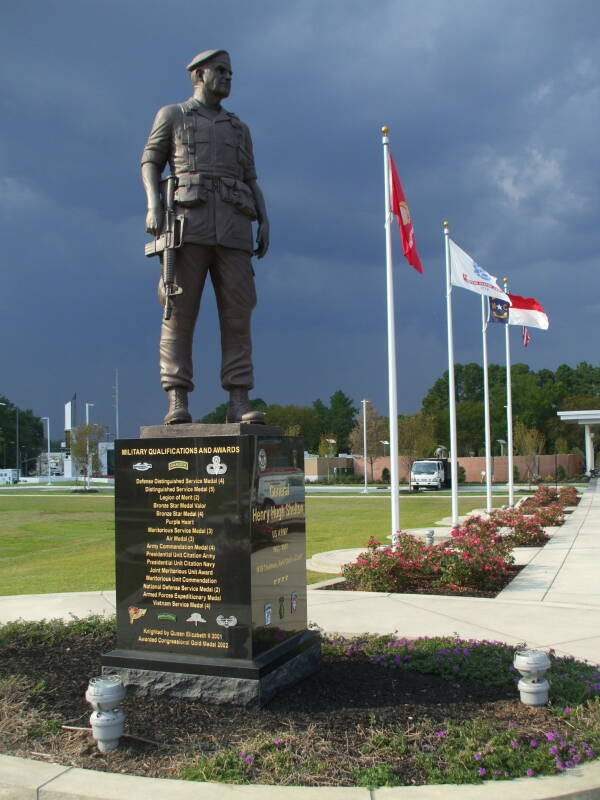
The Airborne and Special Operations Museum is near downtown, just across the tracks from the Amtrack station.
Time for some terminology, Special Operations versus Special Forces:
The U.S. Army's Special Operations Command includes the 75th Ranger Regiment, the 160th Special Operations Aviation Regiment, the 4th Military Information Support Group, the 95th Civil Affairs Brigade, and the 528th Sustainment Brigade.
Other Special Operations groups under the unified United States Special Operations Command (USSOCOM) include the U.S. Marine Corps Forces Special Operations Command (MARSOC), the U.S. Naval Special Warfare Command (NAVSOC or SPECWARCOM), and the U.S. Air Force Special Operations Command.
Within SOF are the Army's Special Forces Command (USASFC), also known as the Green Berets, and far less known publicly, the 1st Special Forces Operational Detachment-Delta (1st SFOD-D), referred to by the Department of Defense as the Combat Applications Group and commonly called Delta Force or simply Delta.
Anyway, the Airborne and Special Operations Museum is nicely put together. It concentrates on elite Army Special Operations units from World War II through the present. It is large enough to hold a C-47 transport plane and a Waco glider from World War II, and a UH-1 "Huey" helicopter from the Vietnam War.
The plaza in front of the museum has a statue of General Henry Hugh Shelton, U.S. Army 1963-2001, 14th Chairman of the Joint Chiefs of Staff, as seen above.
In honor of
Airborne Troopers
whose courage,
dedication, and
traditions make them
the world's finest
fighting soldiers.
The "Iron Mike" airborne infantryman statue is directly in front of the museum.
The original "Iron Mike" was cast in bronze and installed on base at Fort Bragg. It was starting to deteriorate, so an exact replica was made by making casts of the original.
Fort Bragg — JFKSWS and the Special Forces Museum
The other two museums I visited are on base at Fort Bragg. You can freely visit the base after showing identification and having your vehicle searched at the main gate.

This statue of Colonel Arthur D "Bull" Simons faces the John F. Kennedy Special Warfare Center and School. The statue's base quotes him: "History teaches that when you become indifferent and lose the will to fight someone who has the will to fight will take over."
Simons was commissioned as a Second Lieutenant in 1941 and served in the harsh jungles of New Guinea. Promoted to Captain and commanding a newly forming Ranger battalion, he took part in several hazardous landings in the Pacific.
In Luzon in the Philippines in January 1945 he took part in the raid on Cabanatuan that rescued about 500 POWs who were mostly survivors of the Bataan Death March. He left active duty after the war at the rank of Major.
He was recalled to active duty in 1951 to serve as an infantry and Ranger instructor. He joined the 77th Special Forces Group in 1958, was in Laos 1961-1962, Panama 1961-1964, and then was assigned to MACV-SOG in Vietnam.
Simons was selected as ground commander of Operation Ivory Coast, a joint special operations raid in November 1970 to rescue 61 American prisoners of war being held in the Son Tay prison in North Vietnam. An intelligence failure meant that the raiders did not know that the prisoners had been moved a few months earlier. The raid did force North Vietnam to move all the prisoners to a few central compounds in Hanoi, leading to improved treatment and prisoner morale.
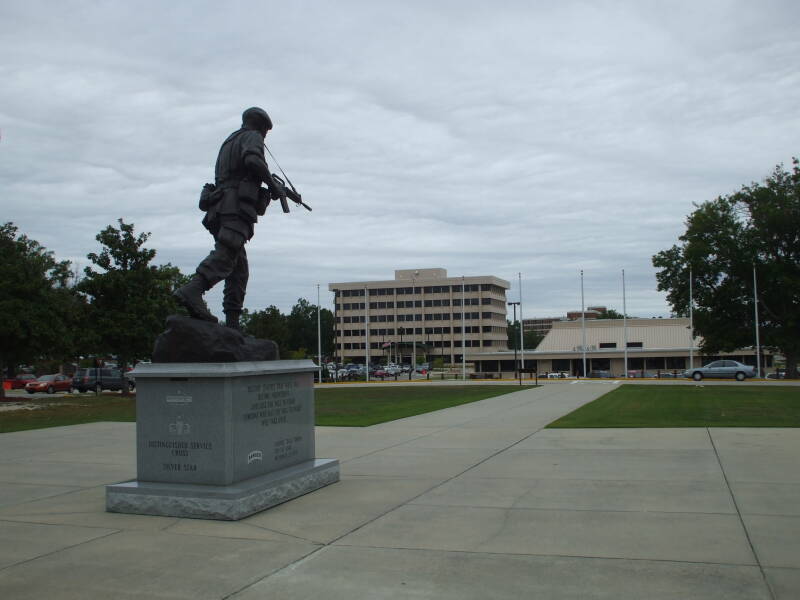
He retired as a Colonel in 1971. In late 1978, he was contacted by Ross Perot after two Electronic Data System employees had been imprisoned in Iran shortly after the Iranian Revolution.
Simons organized a rescue mission that freed the two men from the Iranian prison, as described in Ken Follett's On Wings of Eagles.
Amazon
ASIN: 0451213092
Colonel Simons' statue faces the U.S. Army John F. Kennedy Special Warfare Center and School, or USAJFKSWCS, informally called SWCS or "Swick". It grew out of the PSYWAR Center and School, developing the doctrine, techniques, training and education of Special Forces and Psychological Operations.
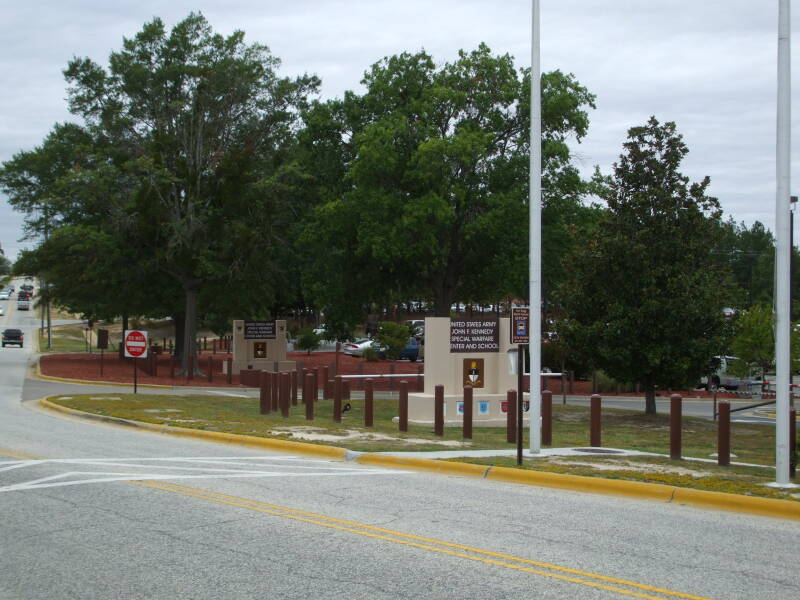
The school's responsibilities expanded in 1960 to include counterinsurgency operations. Then, in 1962, it established a Special Forces Training Group to train volunteers for operational assignment in Special Forces units.
It was reorganized in 1985 from the Special Warfare Center to the Special Warfare Center and School.
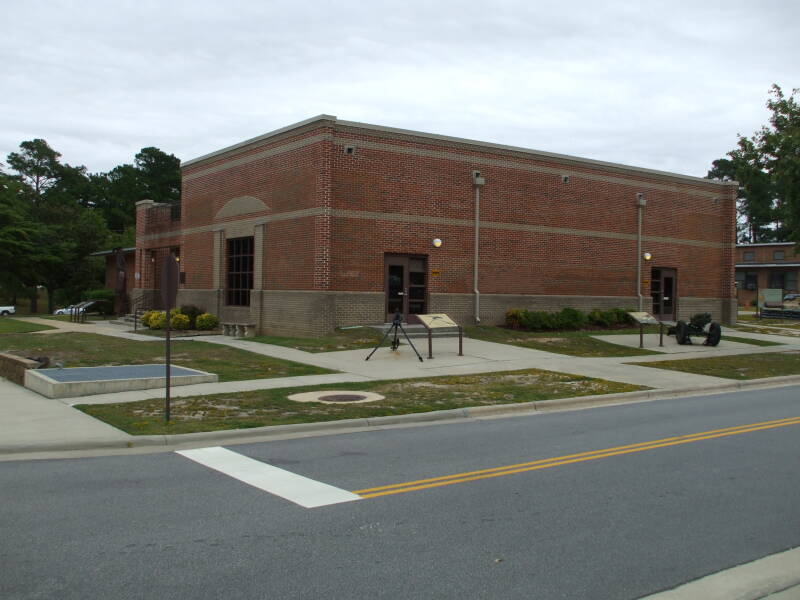
The John F. Kennedy Special Warfare Museum is next to that plaza and across the road from USAJFKSWCS. Operated by a volunteer organization, it presents some of the history in which the Green Berets have played a part.
This locally made carpet was given to a Special Forces unit deployed in Afghanistan.
It depicts Jesus and four angels, George W. Bush wearing papal vestments, lions and the U.S. Presidential seal.
The Afghans get religion and American politics just as mixed together as some American politicians do. As the nearby placard explains, the Afghans cannot imagine a national leader who is not also in charge of national religious affairs.
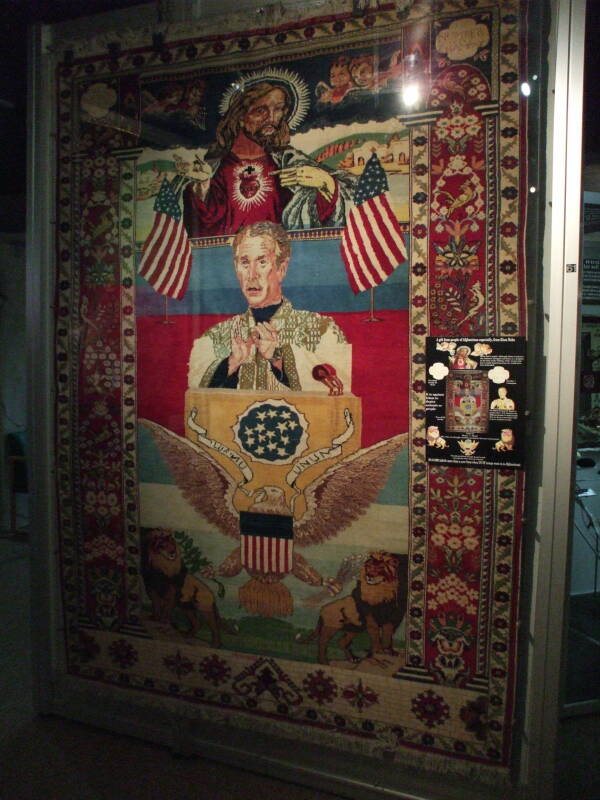

These gold-plated guns were seized from Uday Hussein's palace in Baghdad by Special Forces ODA-574 on 12 April 2003. All are inscribed in Arabic, "This is a gift from Mr. President Saddam Hussein, President of Iraq." The rifles have inlaid Iraqi eagle medallions.
Top to bottom: a paratrooper 7.62x39 mm AK-47 with folding stock, 7.65 mm Baretta pistol, 7.62x54mmR SVK Dragunov sniper rifle.
The sniper rifle's case is engraved with a plaque reading "Made by the arms (parts) of the martys of the war of Al-Kadisiya", Saddam Hussein's reference to the 1980-1988 Iraq-Iran war named after one of the eighth century battles against the Persians.
The medallion on the pistol shows the profile of Tariq ibn Ziyad, the Iraqi commander of the Berber Army in 711 A.D. He led the Berbers to conquer Persia, Spain and parts of France. This began a period of Islamic rule lasting in Spain until 1492.
Enemy weapons seized by Special Forces in Afghanistan include these AK-47 and M1 Garand rifles and a SA-7/HN-5 surface to air missile launcher in the John F Kennedy Special Warfare Museum.

The AK-47 is a 7.62x39 mm selective fire assault rifle. It is a hybrid of previous rifle technologies: the trigger, double bolt locking lugs and unlocking raceway of the M1 Garand and M1 Carbine; the safety mechanism of John Browning's Remington Model 8 rifle, and the gas system and overall layout of the German Sturmgewehr 44.
The AKM ("M" for "Modernized") was introduced in 1959, with a stamped sheet metal receiver and a slanted muzzle brake to compensate for muzzle rise under recoil. A cyclic rate reducer or hammer retarder was added to prevent the weapon from firing out of battery (with the bolt incompletely closed) during rapid automatic fire.
This M1 Garand rifle was captured in Afghanistan after it made its way there through who knows how many conflicts. According to its markings ("6528287 IHC" on the bolt), it was made some time around 1953 by International Harvester.
The HN-5 was the designation for the Chinese manufactured version of the Soviet 9K32 Стрела-2 or Strela-2, designated SA-7 "Grail" by NATO. It was the first generation of Soviet man-portable surface-to-air missiles, first entering service in 1968.
The Chinese HN-5 was the result of reverse engineering the Soviet Strela-2, and was known to its builders as the Hong Ying-5 or "Red Parakeet". It has an operational range of 800 to 4400 meters, a flight ceiling of 2500 meters, it moves at 500 meters per second, and is guided by an infrared seeker head. Its 0.5 kg gram warhead is detonated on impact.
Fort Bragg — 82nd Airborne Division Museum
The 82nd Airborne Division, the primary fighting arm of the XVIII Airborne Corps of the U.S. Army, has a history museum on Fort Bragg. This Lockheed C-130 "Hercules" is on the lawn in back of the museum.

It's a four-engine turboprop transport introduced in late 1957 and still in service for more than 60 nations. The design goal was for it to carry 92 passengers, 72 combat troops or 64 paratroopers with a loading ramp at the rear of the fuselage. The cargo compartment is approximately 41 feet long, 9 feet high, and 10 feet wide. Over 2,300 C-130s have been built at Lockheed's plant in Marietta, Georgia.
This specific aircraft is a C-130E, USAF 64-0525. The C-130E is an extended range model that entered service in 1962, it's basically a C-130B with 5,150L external fuel tanks and more powerful Allison T56-A-7A turboprop engines.
| Range | 2,420 miles / 3,896 km | |
| Cruise speed | 340 mph / 295 kt / 547 km/h | |
| Max speed | 384 mph / 334 kt / 618 km/h | |
| Ceiling | 23,000 feet / 7,010 m |
The Curtiss-Wright C-46 "Commando" was the first aircraft with jump doors on both sides of the fuselage. It was used as a military transport and for airborne operations from 1945 to the 1960s.
It was derived from a commercial high-altitude airliner design, and was known to its crews as "The Whale" and the "Curtiss Calamity". Preliminary designs were built in the late 1930s, with production as the C-46 starting in September, 1940.
The C-46 was most famous for flying "over The Hump" in the China-Burma-India theatre, transporting supplies into China from Allied bases in Burma and India. It had to deal with flying over the Himalaya Mountains in severe weather while operating out of rough and frequently flooded airfields. It had twice the cargo capacity of the C-47.
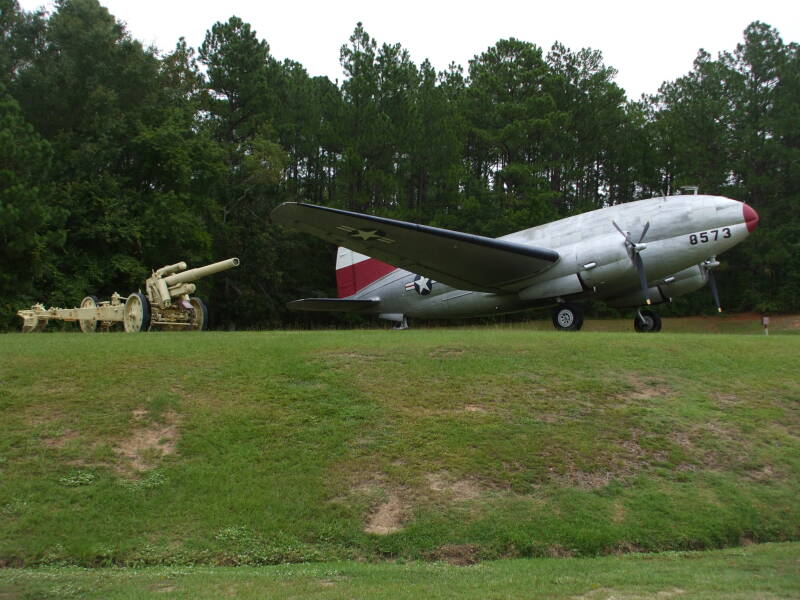
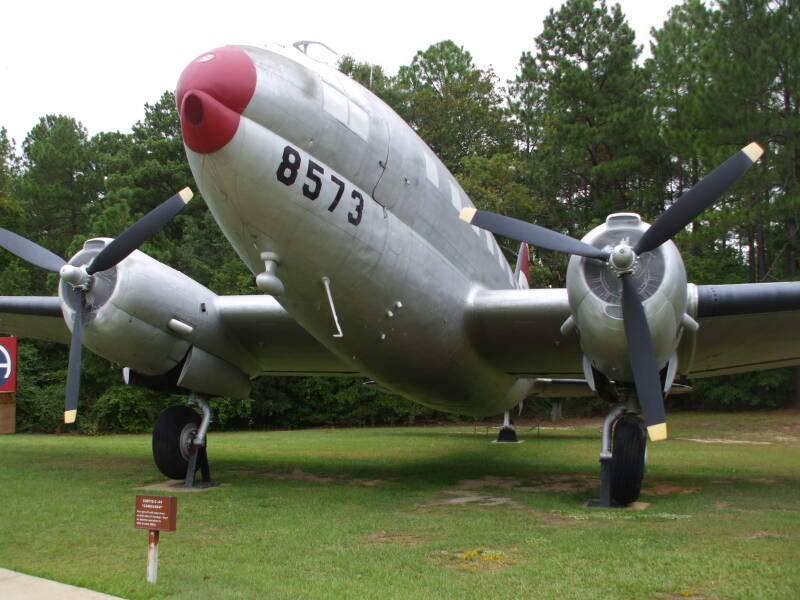
The unusual "figure eight" or "double bubble" cross-section has a crease at the passenger compartment's floor level, better enabling the fuselage to withstand the pressure differential at altitude.
The 82nd Airborne's commander, General Matthew Ridgeway, issued an order that the C-46 be used for no further airborne operation after a large number of them were lost during Operation Varsity on 22 March 1945, securing a foothold across the Rhine into western Germany near Hamminkeln and Wesel. However, the paratroop drop was flown at slow speed at very low altitudes in daylight over heavy concentration of German 20 mm, 37 mm, and larger caliber antiaircraft guns, so the heavy losses may have been no fault of the C-46 design.
The C-46 remained in U.S. Air Force service in a secondary role until 1968, flying resupply missions, paratroop drops, and clandestine agent transportation in Vietnam. It had been used for several clandestine operations in the late 1940s and early 1950s, flying as part of the CIA's Civil Air Transport and Air America to resupply Chiang Kai-Shek's troops in China and to transport military and medical supplies to French forces in French Indochina. It was also used in the 1961 Bay of Pigs invasion in Cuba.
The C-46 continues in non-military operation as a cargo transport for the Arctic and remote locations. Buffalo Airways operates three C-46s in the Canadian Arctic.
| Range | 2,950 miles / 4,750 km | |
| Cruise speed | 173 mph / 150 kt / 278 km/h | |
| Max speed | 269 mph / 234 kt / 433 km/h | |
| Ceiling | 27,600 feet / 8,410 m |
The Douglas C-47 "Skytrain" or "Dakota" was the military version of the DC-3 airliner. It was informally called the "Gooney Bird", especially in the European theatre of operations. Over 10,000 were produced at the Douglas Aircraft plants in Long Beach and Santa Monica, California, and Oklahoma City, Oklahoma. It first flew in December, 1941, and remained in service with the USAF Strategic Air Command through 1967.
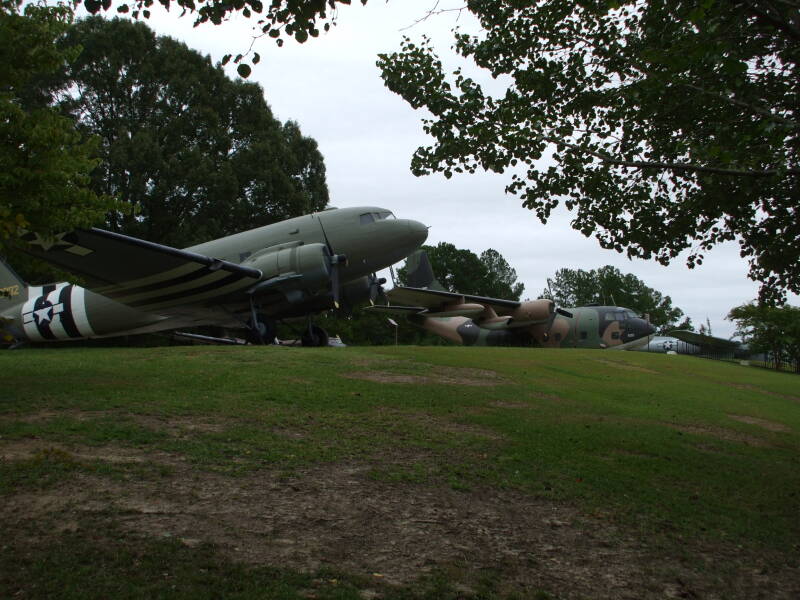
Three advanced electronic warfare versions were flown by the USAF during the Vietnam War, designated EC-47N, EC-47P, or EC-47Q depending on the engines, and called the "Electric Gooneys". The Vietnamese, Laotian, and Cambodian Air Forces also flew the EC-47.
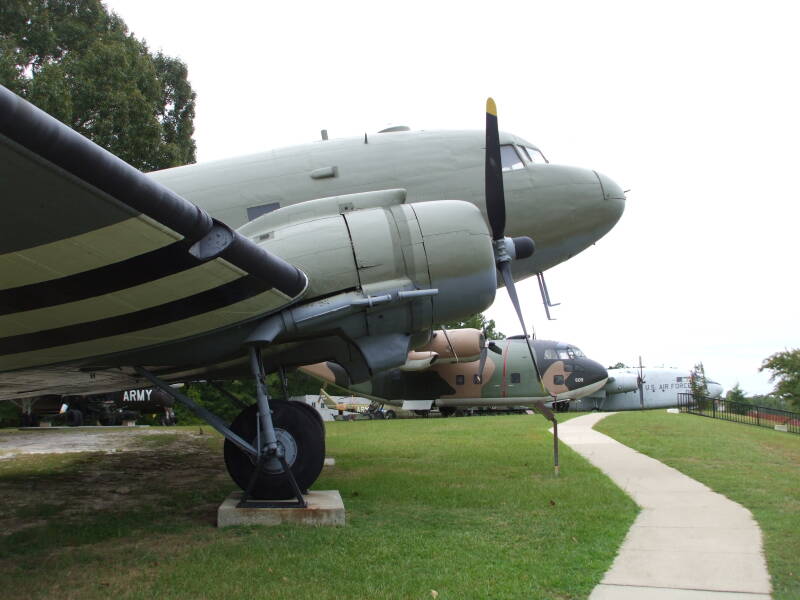
Then there was the AC-47 "Spooky" or "Puff the Magic Dragon", a gunship version with three 7.62 mm miniguns. The target area was an elliptical area approximately 52 yards in diameter, with a 7.62 mm round placed every 2.4 yards during a 3-second burst. Upgraded AC-47s are still in service in Columbia against local illegal armed groups. They have turboprop engines, an overhauled airframe, and fire 12.7 mm (.50 calibre) machine guns slaved to a FLIR targeting system. The locals call them Avion Fantasma or "Ghost Planes". The El Salvadoran Air Force still operates very similar upgraded AC-47s supplied to them by the U.S. in 1984-1985.
The civilian DC-3 version made its first flight in 1935 and many are still in service today. American Airlines started its passenger service with the DC-3 in June, 1936, between Newark, New Jersey (near New York city) and Chicago. KLM received its first DC-3 in 1936, putting it into service from Amsterdam through Batavia (now Jakarta) to Sydney.
| Range | 1,600 miles / 2,575 km | |
| Cruise speed | 160 mph / 139 kt / 257 km/h | |
| Max speed | 224 mph / 195 kt / 360 km/h | |
| Ceiling | 26,400 feet / 8,045 m |
This C-7 "Caribou" is sitting behind a M-167 Vulcan Air Defense System. The Vulcan is based on a six barrel 20 mm rapid-fire Gatling gun. It saw service with the 82nd Airborne Division from 1970 to 1994. This specific weapon fired on enemy aircraft in Iraq during the Persian Gulf War.
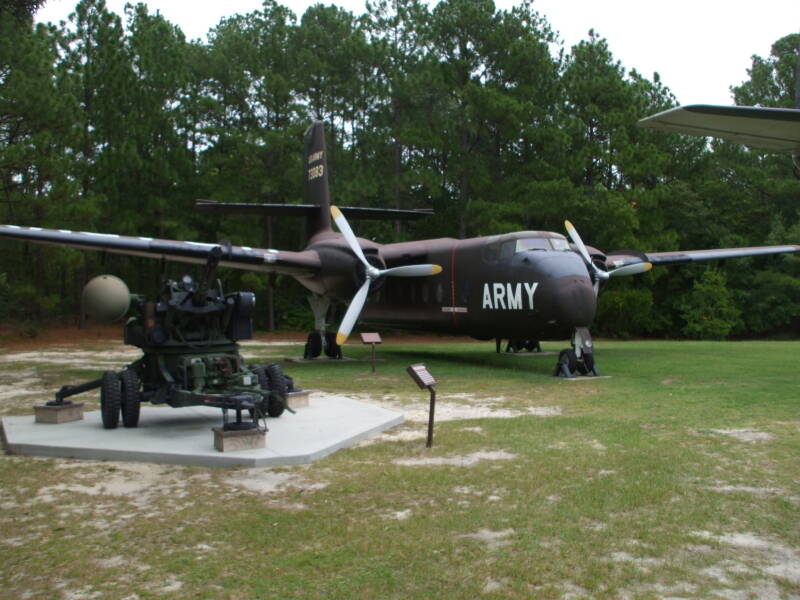
It can be driven hydraulically, pneumatically or electrically and fired at 3,000 rounds per minute in short bursts of 10, 30, 60, or 100 rounds, or in a continuous fire mode at 1,000 rounds per minute.
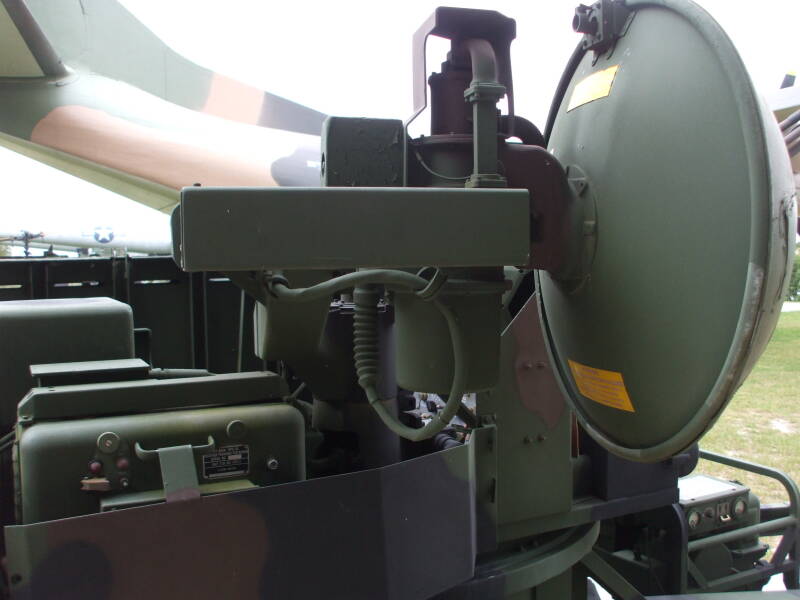
This system uses the small range-only AN/VPS-2A radar, with an RT-860A/VPS-2A radar receiver-transmitter seen at lower left here. The AN/VPS-2A operates at 9.205-9.245 GHz, with 10.4 watts of average power to a 60 cm diameter parabolic dish antenna. The radar is used in conjunction with an optical sight.
The de Havilland Canada C-7 "Caribou" is a specialized short takeoff and landing cargo aircraft. It was first flown in 1958, and while it was primarily used as a military tactical transport, a few are still in civilian use as rugged "bush" aircraft.
The U.S. Army purchased 159 of them, using them for tactical transport in the Vietnam War in situations where larger cargo aircraft could not land on the shorter landing strips. The C-7 could operate out of runways only 1200 feet (365 m) long. The North Vietnamese captured a few of these, and operated them until the late 1970s.
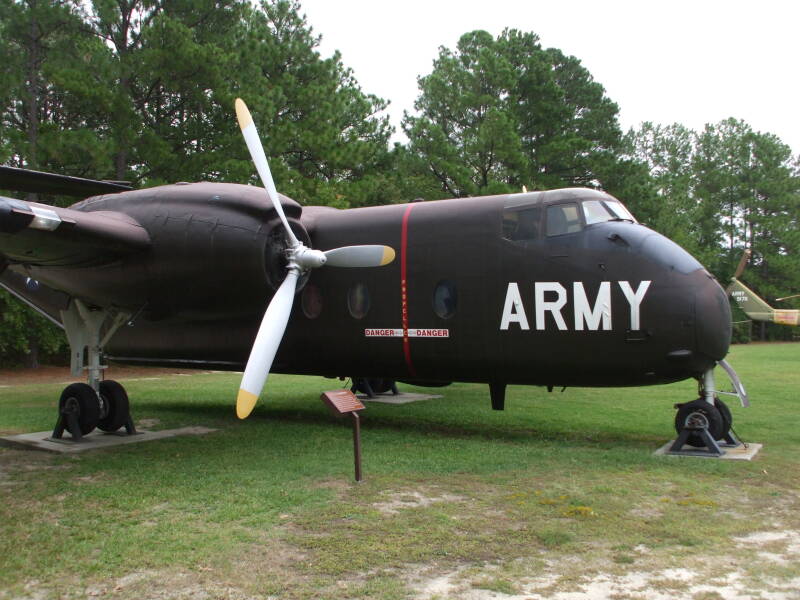
The last C-7 Caribou used by the U.S. military was flown for the U.S. Army's Golden Knights parachute demonstration team through 1985. This one was used by the Golden Knights, it might have been the last operational one as the Golden Knights are based at Fort Bragg.
The Royal Australian Air Force retired its last Caribou in November, 2009. Brazil's military is slowly replacing their remaining ones with the EADS CASA C-295.
| Range | 1,280 miles / 2,060 km | |
| Cruise speed | 181 mph / 157 kt / 291 km/h | |
| Max speed | 216 mph / 188 kt / 348 km/h | |
| Ceiling | 24,800 feet / 7,559 m |
The Fairchild C-119 "Flying Boxcar" made its first flight in 1947, over 1,100 were built through 1955, and was used by the U.S. military through 1974. The Republic of China Air Force flew them through 1995.
It saw heavy use through the Korean War as a troop and equipment transport. It first saw military use in Vietnam in 1953, being secretly loaned by the CIA to French forces. They were painted with French markings and flown by U.S. CIA pilots with French officers and support staff. These played a major role during the March-May 1954 siege of Dien Bien Phu.
Other C-119s were used to capture film canisters dropped by surveillance satellites. Many of these were lost, the first successful film capture was in August 1960.
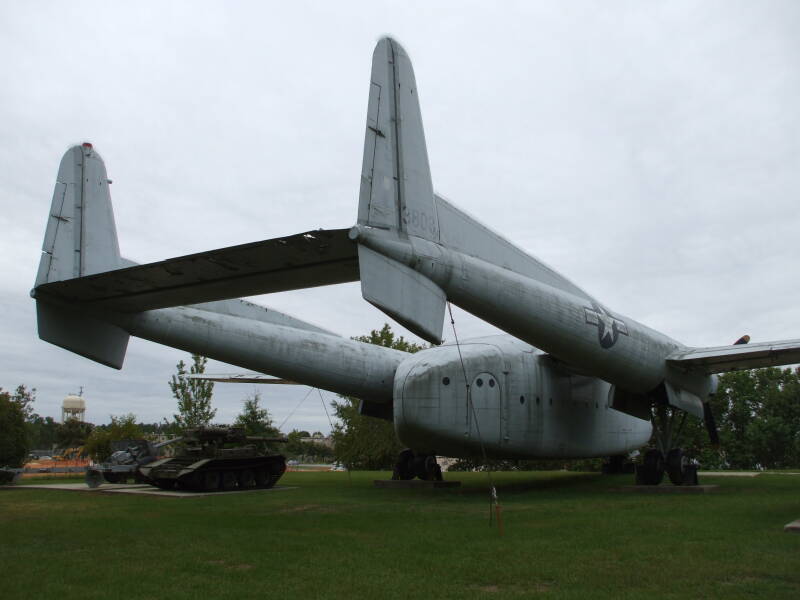

The U.S. Bureau of Land Management used then as air tankers to drop water on wildfires, while others went into civilian cargo service. They were used in Alaska for delivering building materials to villages in the bush with no road access. Two are still operable out of Palmer, Alaska.
| Range | 2,280 miles / 3,670 km | |
| Max speed | 296 mph / 257nbsp;kt / 450 km/h | |
| Ceiling | 23,900 feet / 7,290 m |
The Bell UH-1 "Iroquois" was better known as the "Huey", and while many people associate it with the Vietnam War, models are still in U.S. service. About 7,000 UH-1s were operated in Vietnam.
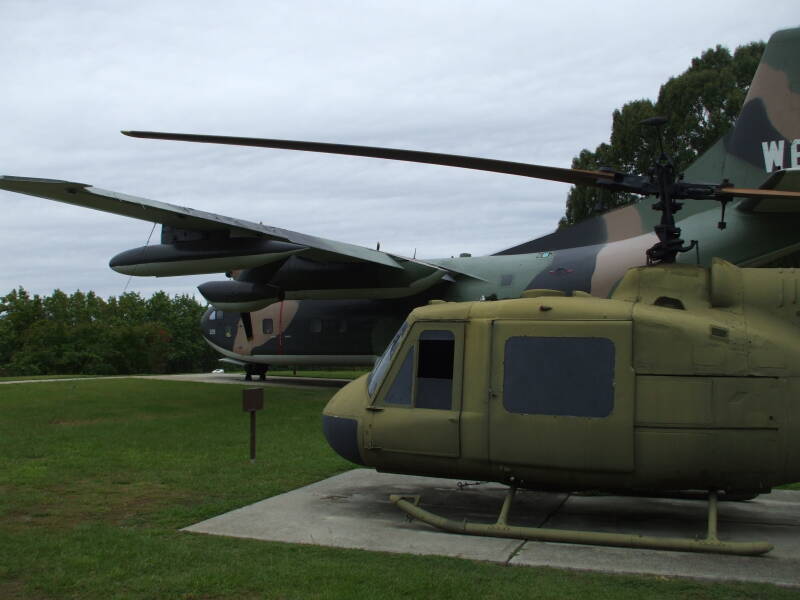
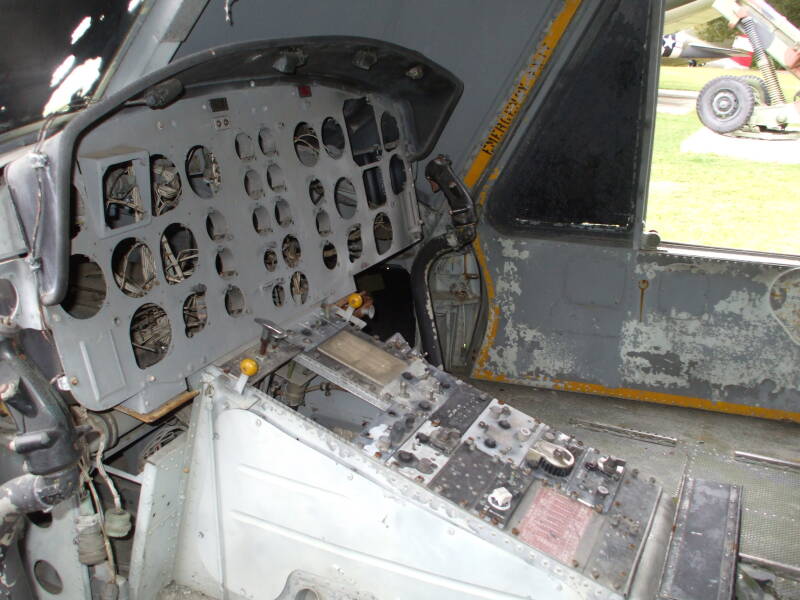
This helicopter is pretty much a shell: the instrument panel, some of the controls, the seats, and more have been removed.
| Range | 315 miles / 507 km | |
| Cruise speed | 125 miles / 109 kt / 201 km | |
| Max speed | 135 mph / 117 kt / 217 km/h | |
| Ceiling | 19,390 feet / 5,910 m |
The Fairchild C-123-K "Provider" was developed in the late 1950s. It was originally designed as an assault glider. The eventual piston-powered design was very useful for tactical transport due to its performance from short and unimproved runways. It was also used for the Agent Orange based defoliation operations in Vietnam. Some of the aircraft modified for aerial spraying were the last C-123s to see military service, when they were used for insect eradication spraying. The C-123 was used for parachute instruction at Fort Benning, Georgia, into the early 1980s.
A C-123 operated by the CIA under the cover of Corporate Air Services was shot down in Nicaragua on 5 October 1986. It was carrying 70 AK-47 rifles, 100,000 rounds of ammunition, rocket powered grenades and other supplies. The two CIA pilots and a radio operator were killed, but loadmaster Eugene Hasenfus inconveniently survived, having disobeyed orders by wearing a parachute. He was taken prisoner by the Sandinista Nicaraguan military and sentenced to 25 years in prison. In December of that year he was pardoned and released, but his capture had helped uncover and publicize the Iran-Contra Affair.
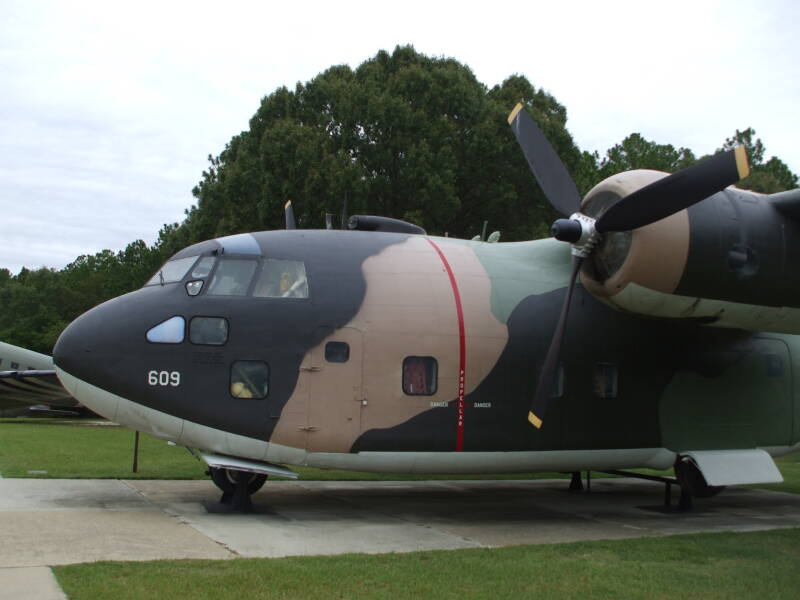
| Range | 1,035 miles / 1,666 km | |
| Max speed | 228 mph / 198 kt / 367 km/h | |
| Ceiling | 29,000 feet / 8,800 m |
Normandy
Among the memorials near the museum entrance, this model shows the church in Sainte-Mère-Église in Normandy. 82nd Airborne paratrooper John Steele is shown trapped on with his parachute caught on the steeple early on the morning of 6 June 1944.

Once inside, the museum has a lot of information and displays of equipment. It follows the history of the 82nd Airborne from its origins in August 1917 to today.
Wait a minute, 1917? Airborne? No, not yet.
The 82nd Division was established in August 1917 at Camp Gordon, Georgia, consisting entirely of newly conscripted soldiers. Its initial members came from all 48 states (this was before Alaska and Hawaii were states), so it was called the "All-American" division, and hence its "AA" shoulder patch. It was mostly made up of two Infantry Brigades of two regiments each, plus a Field Artillery Brigade. The 82nd Division sailed to Europe and joined the American Expeditionary Forces in World War I.
VisitingSalerno Visiting
Bastogne
The 72nd Division existed only as a unit of the Organized Reserve 1922-1942. It was recalled to active duty in March 1942. In August 1942 it became the Army's first airborne division and was redesignated the 82nd Airborne Division. Its first two combat operations were parachute assaults into Sicily on 9 July 1943 and Salerno, Italy on 13 September 1943. The first of those was the first regimental-sized combat parachute assault by United States forces. The 82nd Airborne was then involved in Operation Overlord, the D-Day landings in Normandy; Operation Market Garden, in the Netherlands; and the Battle of the Bulge in the Ardennes Forest around Bastogne in southern Belgium.
Small Arms
U.S. Airborne Infantry World War II Small Arms.
Left to right, top to bottom:
- M1 Garand rifle, .30-06.
- M1911A1 pistol, .45.
- Thompson submachine gun, .45.
- M1A1 carbine, .30.
- Model 1903A4 Springfield rifle, .30-06, with M82 telescopic sight.
- M1 2.36 inch rocket launcher, or "bazooka".

German Infantry World War II Small Arms.
Left to right, top to bottom:
- Model 98K carbine, 7.92 mm.
- Gewehr/Karabiner 43 semiautomatic rifle (G43).
- MP44/StG44 assault rifle, 7.92 mm.
- MP-40 machine pistol, 9 mm.
- Luger Model P08 Pistol, or Pistole Parabellum 1908, 9 mm.
- MP34 submachine gun, 9 mm.
- Walther Model P38 Pistol, 9 mm.

Operation Desert Storm captured Iraqi weapons.
Left to right, top to bottom:
- Romanian 7.62 mm FVR Dragunov style sniper rifle, 7.62x54mmR.
- Yugoslav 7.62x25 mm Model 57 pistol, Yugoslav variant of the Soviet Tokarev TT-33.
- Soviet design 7.62 mm AKM rifle.
- Iraqi 9 mm "Tariq" pistol, Italian Beretta M1951 design.
- RPK 7.62 mm light machine gun.
- Iraqi built night vision sight for the AKM rifle.
